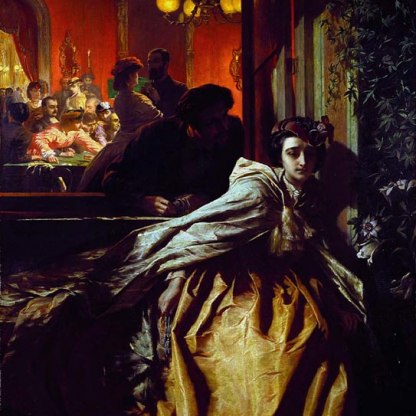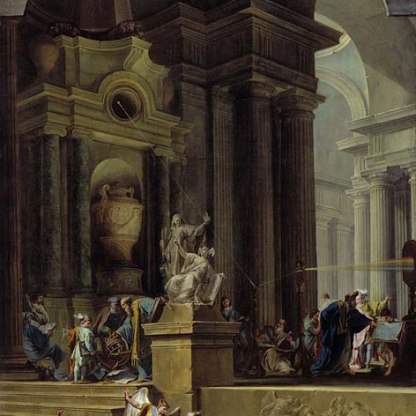Seated Woman: Cup of Coffee, 1893

Edouard Vuillard was one of a group of young Parisian art students who in 1888 formed a secret brotherhood called 'the Nabis'. The name derived from the Hebrew word for 'prophets', and though there was nothing particularly Jewish about their philosophy, the name does suggest their almost religious sense of mission.
While the Impressionists, such as Renoir, whose work A Gust of Wind can be seen in the Fitzwilliam [2403], painted in the open air, and were concerned with the effects of natural light on natural forms, the Nabis looked, as Vuillard does in this early work, to the interior: the interiors of homes and the interior lives of people, both subject and artist. It was not so much light as pattern that fascinated them. They were less interested in nature than in emotion. These young prophets preached the gospel according to the painter Paul Gauguin. Their icon was a work by Paul Serusier, which they called 'The Talisman', an expressionistic landscape painted under Gauguin's guidance, in the south of France.
The style of this interior by Vuillard shows well his Nabi credentials, although many of his colleagues worked on a larger scale. A woman is taking a break from domestic work. The sitter is actually Vuillard's sister, Marie. Her broom lies against the door jamb. There is a cup of coffee on the table beside her. She sits, hands folded on her knee, staring into the middle distance. It is a private, restful moment, the kind of non-event that might have taken place in countless middle-class households all over Paris on any given day in the 1890s. But if the subject-matter is mundane, Vuillard's treatment of it is anything but.
The light pink of the left side of the woman's face and her hands shows us that this woman is real, fleshly. But otherwise she harmonises entirely with the room in which she so quietly and unobtrusively sits. The shadow on the left side of her face is made up from the colours of her dress, the wallpaper and the tablecloth. The shape of her body is effectively camouflaged, scarcely distinguishable against the patterns behind her. Her garment seems to buzz where the creases and folds catch the greeny-yellow light.
Her hair reflects the same highlights. The broom takes on the colour of the floral pattern on the wallpaper. Only the blue and white coffee cup, cropped at the left of the picture, retains its own discrete colours. It reminds us of the reality behind this otherwise expressionistic scene.
The woman, then, is an integral part of her interior, and seems to both absorb and reflect the colours around her. Does the room somehow suggest her inner life? Do the tones and patterns reflect her mood and state of mind?
Vuillard, who never married, grew up in a household of women: his widowed mother and Marie ran a dressmaking workshop in the family home. Many of his early works show women indoors, at work or at rest, and there is a strong sense of sympathy between artist and subject. The example in the Fitzwilliam, though highly modern in style, reflects Vuillard's interest in seventeenth-century Dutch interiors, such as those painted by Vermeer.
In the period when he made this painting, Vuillard was sharing a studio with fellow Nabi, Pierre Bonnard. The Oil Lamp [PD.28-1998], an interior by Bonnard in the Fitzwilliam, shows just how close the two painters were in outlook. With their liking for flat colours and simple lines, and their interest in decorative pattern, the Nabis were admirers of nineteenth-century Japanese woodcuts. The members of the brotherhood gave each other nicknames. Bonnard was known as 'the very Japanese Nabi'. Not to be outdone, the painter Paul Ranson, at whose house ('the temple') the group met, was called 'the Nabi even more Japanese than the Japanese Nabi'.
Themes and periods
Data from our collections database
With Bernheim, Jeune & Fils, Paris, 1903; with Wildenstein, 1946; D.W. Tooth (by 1949) from whose estate, allocated
Legal notes
Accepted in lieu of Inheritance Tax from the estate of Dudley Tooth and allocated to the Fitzwilliam Museum, 1994
Acquisition and important dates
- Method of acquisition: Allocated
- Dates: 1994
Dating
- 1890s
- Production date: AD 1893
Maker(s)
- Vuillard, Edouard Painter
Materials used in production
Read more about this recordOther highlight objects you might like
Suggested Curating Cambridge products
Sign up to our emails
Be the first to hear about our news, exhibitions, events and more…





